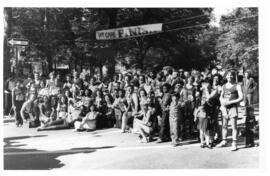This collection contains the private practice records of Dr. Arpad G. C. Gerster. They span almost his entire career as a surgeon in New York City, from 1881-1923. These records are contained in three bound volumes and five boxes. The patient cards were received in three wooden boxes.
The volumes, which were personalized for Dr. Gerster, contain chronological patient records from January 1, 1881 to July 24, 1906. Each patient record has pre-printed slots for the following information: date, age, name and dwelling, business and nativity, diagnosis, treatment, and remarks. Dr. Gerster completed these categories. However, he often had little or nothing to say under 'remarks' and sometimes did not include 'age.' 'Business' was included less often in later years. Presumably, comments under 'treatment' were not completed when not necessary.
The first volume is entirely in German (except for Latin diagnoses). Some of the early entries in the second volume are in English, and by 1892 they are primarily in English. In the front of each volume is an alphabetical index to patients' case records. The last entry in the third volume is on July 24, 1906.
There is a three year gap between the bound volumes of patient records and the first case in the file boxes, which commences on July 26, 1909. Here, cases numbered from 1 - 442 were recorded on pre-printed cards. Some additional questions are included on these cards. These include: civil state, family history, personal history, previous diseases, date of operation, operator, assistant, anesthetist, anaesthetic, amount and examination of urine (chart to be filled in). On the reverse side are pre-printed anatomical drawings for further notations. These forms were clearly meant for use with patients expecting a surgical procedure. However, these cards were often not completed as many patients did not require surgery. Beginning with case number 444 (January 1911) Dr. Gerster ran out of the pre-printed forms and used plain paper to record his patient information. These records reflect the same information as that on the preprinted cards, however they are more difficult to read.
The patient records reflect a private practice of the time. Although Dr. Gerster functioned as a general physician, his practice revealed a bias towards surgically treatable patients. At this time, it would have been difficult to have an exclusively surgical practice because there would not have been enough business to support it. However, because of Dr. Gerster's abilities and prominence, he came as close as possible to having such a practice. Over the span of the records, the types of cases did not show any significant shift in character. The cases have a great deal of variety. Included among the many diagnoses were rheumatoid arthritis, alcoholic hepatitis, acute nephritis, chronic gastritis, double cleft palate, eczema, inguinal hernia, syphilis, vulva cutis, pulmonary tuberculosis, arteriosclerosis, uterine hemorrhage, and many others.
There are a variety of inserts and attachments found throughout the patient records. These include sketches by Dr. Gerster illustrating ailments and abnormalities of patients; correspondence from physicians introducing patients (a number of these are from out of state and many are not in English); pathology lab reports from both the German Hospital and Mount Sinai regarding excised tissue; correspondence from patients; and two radiographic images. (These images are located in: Case Book Number 3, April 17, 1901, and Card File Box 1, in front of Case 104.)
Private patient records such as these are probably uncommon in hospital archives since they do not directly relate to hospital practice. These records are especially interesting because they occur during a period when surgery became safer and more common and when the rise and dominance of surgery as a method of treatment was seen. Additionally, they are of interest because they are the records of Dr. Gerster, an influential and prominent surgeon during his time.
Dr. Gerster's notes end with case number 3670 on February 23, 1923. The patient records continue to October 27, 1923. An unidentified physician apparently took over Gerster's practice shortly before his (Gerster's) death on March 11, 1923.
Elements area
Taxonomy
Code
Scope note(s)
- The planning and managing of programs, services, and resources.
Source note(s)
- Medical Subject Headings
Display note(s)
Hierarchical terms
Organization and Administration
Organization and Administration
Equivalent terms
Organization and Administration
- UF Administration
- UF Administration and Organization
- UF Administrative Technics
- UF Administrative Techniques
- UF Coordination, Administrative
- UF Logistics
- UF Supervision
- UF Technics, Administrative
- UF Techniques, Administrative






